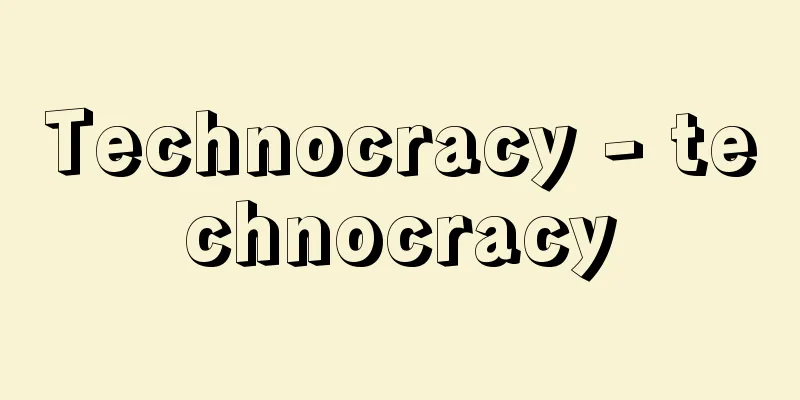Technocracy - technocracy

|
It is a system in which experts with scientific knowledge and advanced administrative and management skills (called technocrats) occupy important positions in the policy-making process and effectively exercise power. This idea has existed since Plato in ancient Greece, but in modern Europe it was advocated by Saint-Simon. Technocracy emerged in the United States in the first half of the 20th century as a kind of social reformism advocated by Veblen and William H. Smith (published in 1919) and was most strongly advocated during the worsening depression of the 1930s, and it can be said that it had some influence on President F. D. Roosevelt's New Deal policy. However, because the New Deal policy was successful in the United States, technocracy as a technological economic ideology that advocates the organization and planning of capitalism was forgotten. After the Second World War, the term came to mean the rule of experts as a characteristic of modern political, economic, and social policy-making institutions more broadly. In his book Technocracy (1964), J. Mainow points out the remarkable rise of so-called technocrats in the fields of high-ranking administrative bureaucrats, military staff officers, science and technology, and so on. In today's world, with the advancement of science and technology, the possibility of those who have knowledge and the ability to utilize it being able to participate in the core of policy-making is increasing. Today, with management experts, administrative bureaucrats, lawyers, professional soldiers, engineers, doctors, university professors, scientists, and other professionals established as professionals, the emergence of governing elites from among them is remarkable. Moreover, today, with the emergence of huge organizations and the dramatic expansion of administrative power, it is becoming difficult for ordinary citizens to understand the workings of these organizations and governments, and experts are needed to plan and form policies for large-scale and complex political, economic, and financial issues. Under these circumstances, advanced industrial societies, both East and West, have strengthened their tendency toward technocracy. For example, even in the Soviet Union, the advance of technocrats was remarkable, and the Soviet Communist Party and government were effectively dominated by technocrats, including party bureaucrats, government bureaucrats, and high-ranking military officers, who were thoroughly trained in specialized jobs and had highly specialized knowledge; they were the so-called nomenklatura. Among European countries, France is the country with the strongest technocratic coloring, and since De Gaulle established the Fifth Republic, there has been a remarkable advancement of elite bureaucrats who graduated with high grades from elite training institutions called Grandes Ecoles, such as the Ecole Nationale d'Administration (ENA), and became financial supervisors or counselors of the State Council, into the political world; Giscard d'Estaing is a good example of this. Moreover, this tendency continued even when the government shifted to the left, and Mitterrand also placed great importance on technocrats. [Hideyuki Kawano] "Modern Thought 5: Technocracy" by Jean Meineau, translated by Juri Shigeru, edited by Shimizu Ikutaro (1973, Diamond Publishing)" ▽ "Modern Sociology Series: Technocracy and Social Movements - The Sociology of Countervailing Complementarity" by Kajita Takamichi (1988, University of Tokyo Press)" ▽ "Nomenklatura - The Soviet Ruling Class" by M.S. Voslensky, translated by Sakuma Muto and Funato Mitsuyuki (1988, Chuokoron-Shinsha), revised and expanded edition (1994, Chuo Koron-Shinsha)" ▽ "Technology vs. Man: The Dangers of a High-Tech Society" by Neil Postman, translated by the GS Research Group (1994, Shinjusha) " ▽ "The World of the Technocrats and Nazism: Utopia of 'Overcoming Modernity'" by Ono Kiyomi (1996, Minerva Shobo)" ▽ "Technocracy" by Bruce Nussbaum, translated by Soichiro Tahara (Kodansha Bunko)" ▽ "Technical Bureaucrats' Political Participation: The Beginning of Science and Technology Administration in Japan" by Shoichi Oyodo (Chuko Shinsho) [References] | | | | | |Source: Shogakukan Encyclopedia Nipponica About Encyclopedia Nipponica Information | Legend |
|
科学的知識や高度の行政・管理能力を有する専門家(テクノクラートあるいはテクノクラットとよばれる)が政策決定過程のなかで重要な位置を占め、事実上権力を行使しているシステムのことをいう。このような考え方は、古代ギリシアのプラトン以来つねに存在してきたといえるが、近代ヨーロッパにおいてはサン・シモンによって主張された。20世紀前半のアメリカにおいてベブレンやウィリアム・H・スミス(『テクノクラシー 国家的産業経営』1919年発表)などによって主張された一種の社会改良主義としてテクノクラシーは登場し、1930年代恐慌が深刻化した時期にもっとも強く主張され、大統領F・D・ルーズベルトのニューディール政策にもある程度の影響を与えたといえる。しかしアメリカにおいてはニューディール政策が成功したため、かえって資本主義の組織化・計画化を説く技術主義的な経済思想としてのテクノクラシーは忘れ去られてしまったといえよう。 第二次世界大戦後このことばは、より広い現代の政治・経済・社会的な政策決定機構の特質としての専門家支配を意味するようになった。J・メイノーは著書『テクノクラシー』(1964)において、高級行政官僚、軍の参謀将校、科学技術などの分野でいわゆるテクノクラートの台頭が著しいと指摘している。科学技術が進歩した今日においては、それらの知識を有し、活用する能力をもつ者が政策決定の中枢に参画しうる可能性はますます増大している。経営専門家、行政官僚、法律家、職業軍人、技師、医師、大学教員、科学者などが専門職として確立した今日、彼らのなかからの統治エリートの出現は目覚ましいものがある。しかも今日では巨大な組織が出現し、行政権が飛躍的に拡大したため、一般国民はそれらの組織や政府の仕組みを理解しにくくなっており、大規模かつ複雑化した政治・経済・財政などに関する計画立案や政策形成にあたる専門家を必要としている。こうした状況の下に、東西を問わず、先進産業社会ではいずれもテクノクラシーへの傾向を強めてきた。たとえばソ連においてさえ、テクノクラートの進出は著しく、事実上ソ連の共産党と政府を支配していたのは、党官僚、政府官僚、高級軍人など、いずれにしても専門職務について徹底的に訓練され、高度の専門知識をもっているはずのテクノクラートであり、彼らがいわゆるノーメンクラツーラなのである。ヨーロッパ諸国のなかでもっともテクノクラシーの色彩が強いのはフランスであり、ドゴールが第五共和政を施行して以来、国立行政学院(ENA)をはじめとするグランゼコールとよばれるエリート養成機関を好成績で卒業し、財務監督官や国務院参事官となったエリート官僚の政界への進出が著しく、ジスカール・デスタンはそのよい例である。しかもこの傾向は政権が左翼に移っても同様であり、ミッテランもテクノクラートを重用した。 [川野秀之] 『ジャン・メイノー著、寿里茂訳、清水幾太郎責任編集『現代思想5 テクノクラシー』(1973・ダイヤモンド社)』▽『梶田孝道著『現代社会学叢書 テクノクラシーと社会運動――対抗的相補性の社会学』(1988・東京大学出版会)』▽『M・S・ヴォスレンスキー著、佐久間穆・船戸満之訳『ノーメンクラツーラ――ソヴィエトの支配階級』新訂・増補(1988・中央公論社)』▽『ニール・ポストマン著、GS研究会訳『技術vs人間――ハイテク社会の危険』(1994・新樹社)』▽『小野清美著『テクノクラートの世界とナチズム――「近代超克」のユートピア』(1996・ミネルヴァ書房)』▽『ブルース・ヌスバウム著、田原総一朗訳『テクノクラシー』(講談社文庫)』▽『大淀昇一著『技術官僚の政治参加――日本の科学技術行政の幕開き』(中公新書)』 [参照項目] | | | | | | | |出典 小学館 日本大百科全書(ニッポニカ)日本大百科全書(ニッポニカ)について 情報 | 凡例 |
Recommend
Hatay (English spelling)
A province in southern Turkey. It borders the Medi...
Shogunate tax - Kubounengu
A term referring to honnengu (tribute tax) in the ...
Brass band
…The English word brass means “shinchu” and refer...
Gerard, J.
…However, during this period, many fake specimens...
Diva
...In 1911, six of D'Annunzio's works wer...
Jamchi - Jamchi (English spelling)
The relay races of the Mongolian and Yuan empires...
Suou (Caesalpinia sappan) - Suou (English spelling) Caesalpinia sappan; sappan wood
A small shrub of the legume family, native to Indi...
Çatal Hüyük (English spelling)
A prehistoric site located 40km southeast of Koniy...
Kazusa Kokufu
...former name of the province. Part of present-d...
East Indian dragon's blood
...Of these, the stems of the Asian genera Daemon...
Chippendale, Thomas
Born: 5 June 1718. Baptised: Attlee, Yorkshire Die...
Astronomica - Asturo no Mika
…Years of birth and death unknown. Author of the ...
Tanker - Tanker (English spelling)
It is a general term for ships that carry liquid ...
Brythonic
…the language spoken by the Celts who inhabited B...
Windhoek - Windhoek (English spelling)
The capital of Namibia, located in the central pa...




![Tanabe [city] - Tanabe](/upload/images/67cc241793fab.webp)




